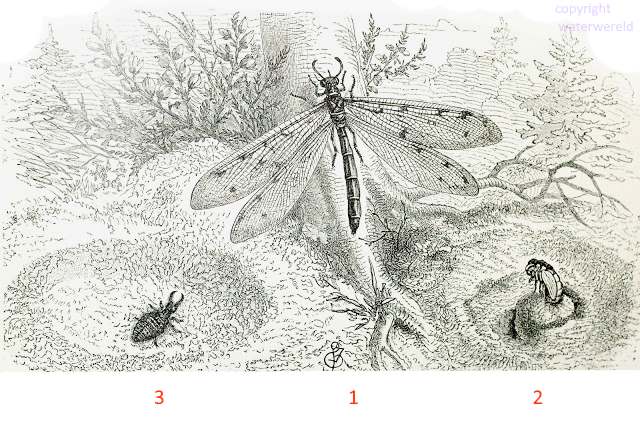Antlion
The antlion is an insect that has a impressive larva with large fangs. The antlion builds a trap to catch ants and other insects. The trap is a pits dug into the ground. Once its prey tries to escape it is bombarded with sand grains.The larvae of antlions are sometimes referred to as “doodlebugs” because of the meandering trails some species leave in the sand as they wander around looking for a place to settle in and find some food. Such a trail can be seen above this page.
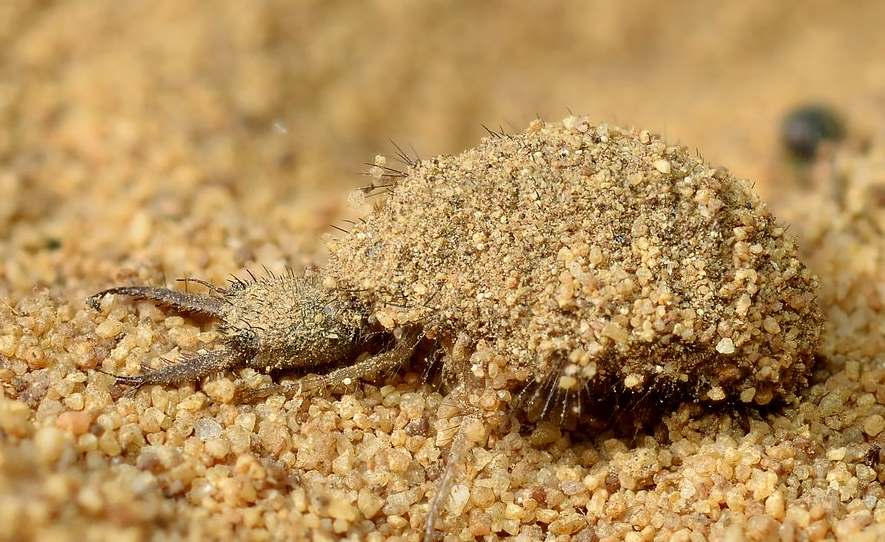 antlion larva has impressive mandibules
antlion larva has impressive mandibules
catching the prey
The antlion in its larval stage can only digest its prey outside its body as there is no mouth: it has only a slith. The function of the large mandible is to keep its prey unmovable while the antlion larva produces an digestive enzym, injected by the hooks. Butthe mandible are not always capable of penetrating the prey and larger insects are strong enough to escape from the mandibles.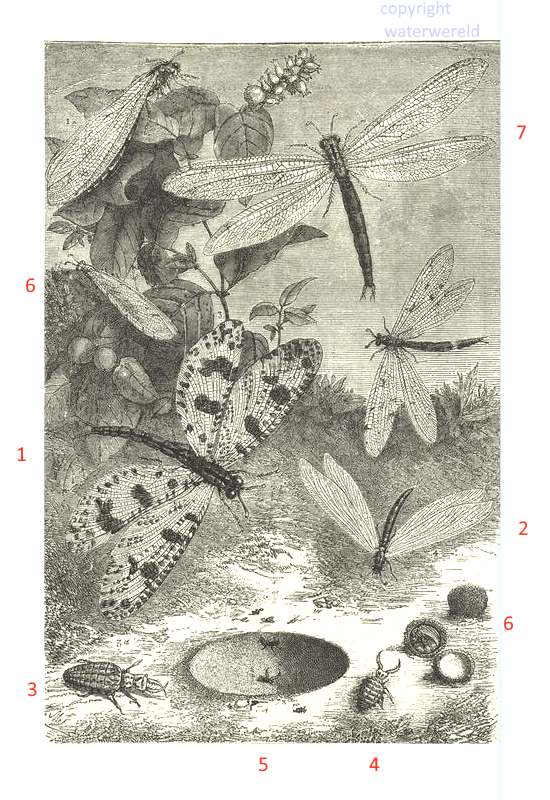
Some highlights from the antlion live1 Adult antlion – Dendroleon obsoletus
2 Egg laying,or “oviposition,
3 The larva leaves it pit in search of a rival larva
4 The larva is called “doodlebug”s as it walks in a uncertain way.
5 The larva waiting inside the trap, a pray is gliding down.
6 The spherical coccoon
7 An adult flying, this is done in an uncertain, clumsy way, and mostly at night
8 An adult feeding on nectar.
Antlion live cycle from Brehm (1880)
Live Cycle antlion
The adult (1)
The life span of the adult is less then a month. During this time they have to feed, find a partner and mate, lay eggs and avoid predators. After emerging from their cocoons and allowing their wings to expand and harden, adult antlions fly into nearby trees. The adults are slow and clumsy fliers , they have a nocturnal live. They rest on dry twigs during the day. At night they hang on the twigs, with raised wings.
mating
Mating takes two hours. The female clings to a twig, the male attaches his tail to hers.the male hangs on the female by only his genital apparatus.. The female clings to a twig. (2)
egg laying
Egg laying,or “oviposition,” occurs in the sand. When a female finds a suitable place, she repeatedly taps the sand surface with the tip of the abdomen. She then inserts the abdomen into the sand and lays an egg (see Figure 2). The eggs are placed near an already existing pit, so there is a danger that an adult becomes victem of the larva.
pupation (2)
pupation occurs under the sand and lasts about three weeks.

The trap of the antlion
The the funnel-shaped pittfall must be build in loose and dry sand, like in dunes. The function of these pittfalls is to catch prey. The ant lion seems to favor dry climates where the pit won’t be destroyed by pouring rain. The pit is build under a tree or overhanging rock to have shelter from direct rain , drowning is a real danger for the larva. But also the attention of birds is dangerous.An antlion pit is lined with fine particles during construction. Since larger particles have a lower angle of repose than smaller particles, fine sand grains tend to stay on the pit walls, whereas larger particles fall to the pit’s centre.
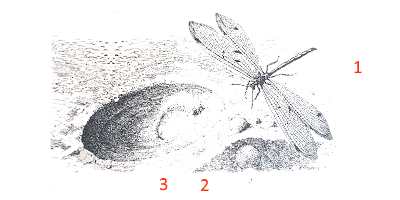
1 adult antlion
2 the prey, an ant , tries to escape
3 antlion larva throwing with sand
Throwing sandparticles
Large particles are used to throw by the larve when the prey is going to escape. Antlions can alter the velocity with which they throw particles. By vibrating their forelegs, antlions appear to sift out the finer particles before each throw. (4)
The antlion is not very succesfull.
Most of the insects that fall into the trap will escape. Some insects are stronger then the fangs of the antlion. An antlion larva can lower its metabolisme and survives a long period without food. The can live for some years. Antlions are no real danger for ants.
cannibalism `between antlions
The larva is very capable to here sounds and vibrations made by other larva and they will be hunted and killed and eaten by the survivor. Also:An adults emerge and lay eggs in the sand near active larvae pits, adults occasionally are captured and eaten by a larva (3)
Antlion belongs to the net-winged insects
The small insect order Neuroptera, or net-winged insects, has very few wellknown members . Antlions and the white footwasp are best known members. Adult Neuropterans have four membranous wings, all about the same size, with many veins. They have chewing mouthparts, and undergo complete metamorphosis. They already existed in the permian and siluur period. (2) The Neuropterans (Lacewings), date back to the Permian, reaching their maximum diversity in the Jurassic, when they appear to have been the most abundant group of flying insects.
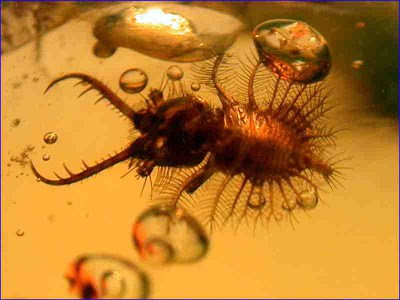
references
1 Trockenstondorte und ihre Lebensgemeinschoften in Mitteleuropo A.KRATOCHWIL,A.SCHWABE BIOLOGISCHEN GRUNDLAGENS. 1-84lnstitut fürChemische Sstonzenphysiotogie derUniversitätTübingen
2 A. G. Ponomarenko & D. E. Shcherbakov (2004). “New lacewings (Neuroptera) from the terminal Permian and basal Triassic of Siberia”
3 YASSERI, A. M. & PARZEFALL, J. (1996) Lifecycle and reproductive behaviour of the antlion Euroleon nostras (Geoffroy in Fourcroy, 1785) in northern Germany (Insecta: Neuroptera: Myrmeleontidae).
Pp. 269–288. In CANARD et al
4 The biophysics of pit construction by antlion larvae (Myrmeleon, Neuroptera) Jeffrey R.LucasAnimal Behaviour Volume 30, Issue 3, August 1982, Pages 651-652, IN1-IN2, 653-664

